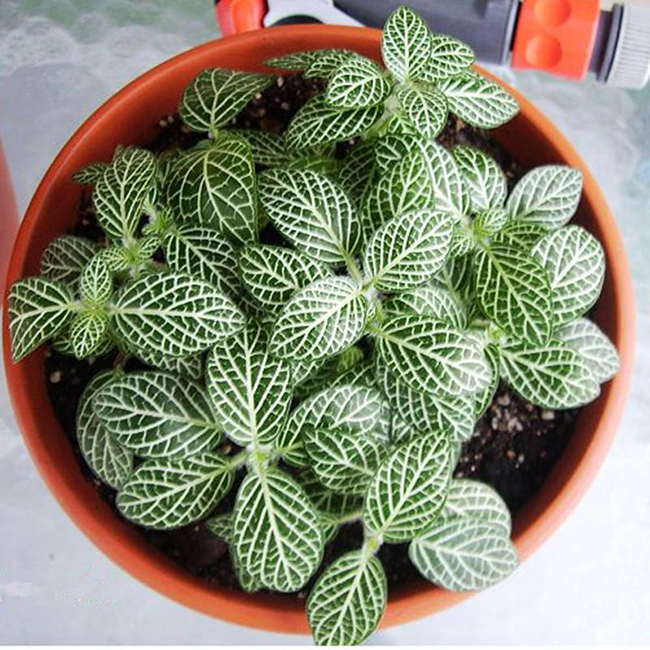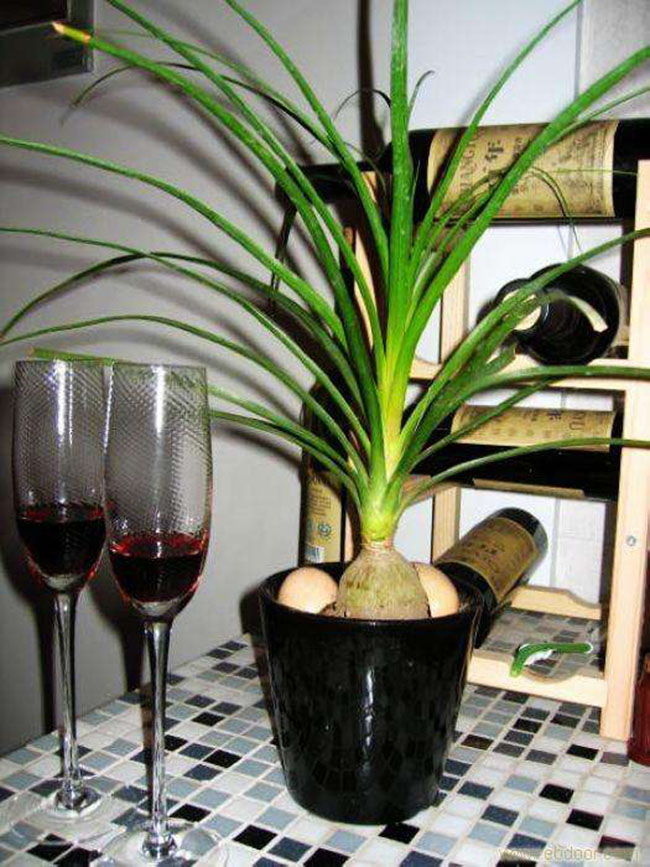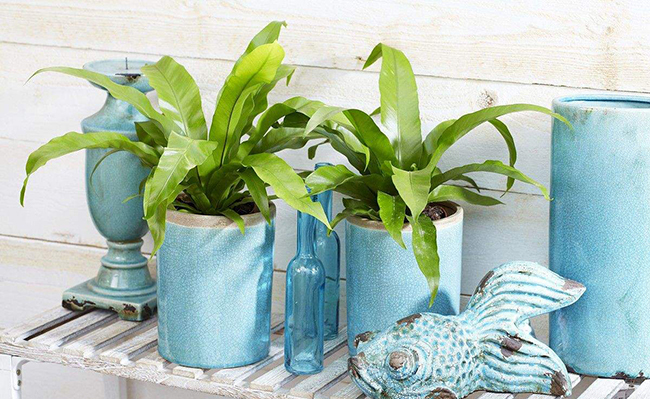Culture methods and matters needing attention of reticulate grass
Growing environment of reticulate grass
Herba Rehmanniae likes high temperature, humid and semi-overcast environment, so it belongs to high temperature plant and is particularly sensitive to temperature. The suitable temperature for growth is 18-24 ℃. The winter temperature is not lower than 13 ℃, and the normal growth can be maintained at 13-16 ℃. When the temperature is below 13 ℃, some leaves begin to fall off, but the stem will not be frozen. If the room temperature rises above 18 ℃, new leaves can continue to germinate. If the temperature is lower than 8 ℃, the plant will die by freezing. During the growing period, higher air humidity is needed. Scattered light is the best, and direct light is avoided. Sandy loam rich in humus should be used.

Culture method of reticulate grass
1. Potted soil:
The best reticulate grass culture soil is the sandy loam rich in humus, which can also be prepared with 50% serpent sawdust, 20% peat moss and 30% river sand. The potted reticulate grass can be mixed with peat soil, rotten leaf soil and river sand.
2. put on the basin:
Reticulate grass cuttings on the pot, should be careful not to damage the roots, and should be separated from fertilizer, to avoid burning roots, watering after planting, and then can be transferred to normal maintenance.
3. Lighting:
Reticulate grass likes medium-intensity light and avoids direct sunlight, but its shade tolerance is also strong. It's best to put it by a bright window indoors.
4. Watering:
The reticulate grass must be watered carefully. If the potted soil is completely dried, the leaves will roll up and fall off. If it is too wet, the stem will rot easily.
5. Fertilization:
For vigorous growing plants, reticulate grass can apply nitrogen-based compound fertilizer with a concentration less than half of the normal concentration every half a month.
6. Temperature:
Reticulate grass likes warmth, the suitable temperature for growth is 18-25 degrees Celsius, the cold tolerance of reticulated grass is poor, the leaves will suffer cold damage when the temperature is below 12 degrees Celsius, and the plant may die at about 8 degrees Celsius.
7. Diseases:
The common diseases of reticulate grass are leaf rot and root rot, the leaf rot is sprayed with 1000 times of carbendazim wettable powder, and the root rot is sterilized by soaking the root with 1000 times of streptomycin.
8. Insect pests:
The insect pests of reticulate grass are harmful to shell insects, red spiders and snails. Shell insects and red spiders are sprayed with 1000 times of omethoate EC, and snails can be caught manually or trapped by snails.
The best breeding time:
Under the condition of suitable temperature, the grass can be propagated by cutting in the whole year, and the cutting effect is the best when the temperature is slightly higher from May to September.
The best growing soil:
For the production of reticulate grass growing soil, you can first put a coarse-grained matrix or ceramsite about 2 cm thick at the bottom of the basin as a filter layer, and then sprinkle a layer of fully mature organic fertilizer as base fertilizer, with a thickness of about 1-2 cm. Cover one of paddy soil, pond mud, rotten leaf soil, can also use vegetable garden soil: slag = 3:1 or garden soil: medium coarse river sand: sawdust (slag) = 4:1:2 mixed soil.
Growth humidity requirements:
Reticulate grass should be in a humid environment, and the growing period needs higher air humidity, especially in the summer high temperature season, the water evaporation is large and the air is dry. In addition to watering to increase the humidity of the basin soil, foliar spraying and ground sprinkling are more necessary. Keeping high air humidity is beneficial to the growth of stems and leaves of Rabdosia paniculata. But the drainage of the basin soil should be good, the water cannot be accumulated, and the leaves can not be soaked in the water fog for a long time, otherwise the color and luster of the leaves will turn white, which can easily cause shedding and decay. But in winter or rainy days, the basin soil can be slightly drier and the air humidity can be moderate.
The optimum growth temperature:
The suitable temperature for growth is 18-25 ℃. The cold tolerance of the grass is poor. If the air temperature is lower than 12 ℃, the leaves will suffer chilling injury, and about 8 ℃ plants may die.
The best growth light:
Reticulate grass likes medium-intensity light and avoids direct sunlight, but its shade tolerance is also strong. It's best to put it by a bright window indoors.
Matters needing attention in breeding reticulate grass
To apply fertilizer:
When fertilizing, reticulate grass also follows the fertilization principle of "light fertilizer applied frequently, less and more times, and complete nutrition", topdressing compound fertilizer once a month.
Watering essentials:
The watering time of reticulate grass should be arranged when the temperature is low in the morning as far as possible. Summer is watered in the morning or evening when the temperature is low, and plants are often sprayed. Winter: the watering time during the winter dormancy period is arranged as far as possible when the temperature is high at noon on a sunny day.
Main points of reproduction:
When reticulate grass propagates, the cuttings can be cut from the stolon that grows out of the basin, about 10 cm long, generally leaving 3 or 4 stem nodes, remove the lower leaves, dry slightly and insert them into the sand bed. If the soil temperature is kept between 24-30 ℃, it can take root at 7-14 days after planting, and it can be transplanted into the pot after 1 month.
Replacement of basin soil:
Reticulate grass in the pot of cutting seedlings, should be careful not to damage the roots, and should be separated from fertilizer, avoid burning roots, watering after planting, and then can be transferred to normal maintenance.
Prevention and control of diseases and insect pests of reticulate grass
The main results are as follows: 1. The common diseases of reticulate grass are leaf rot and root rot. Leaf rot was controlled by spraying 1000 times of carbendazim wettable powder. Root rot disease was sterilized by soaking the root with 1000 times solution of streptomycin.
2. The insect pests of reticulate grass include shell insects, red spiders and snails. Shell insects and red spiders were sprayed with 1000 times of omethoate EC. Snails can be caught manually or trapped by snails.
Experience of breeding reticulated grass:
1. Reticulate grass needs to strengthen air convection in summer so that the temperature in its body can be released; it is recommended to put it in semi-shade, or give it 50% shade; spray it properly, 2 or 3 times a day.
2. Reticulate grass needs to be moved to a brightly lit place for maintenance in winter; if it is raised outdoors, it can be wrapped in a film to survive the winter, but the film should be opened every two days when the temperature is high at noon to let it breathe.
3. When applying fertilizers that are not absorbed by leaves, you should carefully open the leaves to avoid fertilizer damage caused by contact with leaves.
Culture methods and matters needing attention of Rabdosia mandshurica
The white grass plant is small and exquisite, the leaf color is light and elegant, the texture is symmetrical, it is a very good small potted plant. Then how to raise white rinse grass? What do you need to pay attention to in breeding? Let's learn about it next.
First, the culture method of white net grass.
1. Soil: White reticulate grass potted soil is suitable for sandy loam soil rich in humus, and can also be prepared with peat soil or coconut 50%, pond mud 30%, river sand 20%, or loose and water-retaining grass carbon nutrient soil. Because its root system is shallow, it is better to use a large mouth and shallow basin instead of a high and deep basin for planting.
2. Illumination: White reticulate grass should not be exposed to the hot sun in summer, but it needs to grow in the suitable sunlight. Therefore, there should be 6 hours of scattered light at 4m / h every day. If the indoor light is insufficient, the pot plant can be placed under the fluorescent lamp at night to increase the light hours to ensure the plant's demand for weak light.
3. Temperature: the most suitable growth temperature of Rabdosia paniculata is 18 ℃-30 ℃. Avoid cold frost. The overwintering temperature needs to be kept above 10 ℃ in cold winter. When the temperature drops below 4 ℃ in winter, it will go into dormancy. If the ambient temperature is close to 0 ℃, it will die of frostbite.
4. Watering: White net grass watering should grasp the principle of "rather wet than dry", but do not accumulate water. Usually should keep the soil moist, winter cold current attack should pay attention to heat preservation and windbreak, reduce the amount of water. Watering in the morning is better to avoid the retention of water in the leaves at night, resulting in cold injury and decay.
5. Fertilization: White net grass can grow well without fertilization. Granular compound fertilizer or rarefied liquid fertilizer can be applied every 1-2 months, which can brighten the color and luster of leaves. Attention should be paid to avoid fertilizer contact with leaves. In order to maintain the beautiful shape of the plant, the newly planted potted seedlings should be heart-picked many times to promote multi-branching.
II. Matters needing attention in the cultivation of White net Grass
The common diseases and insect pests of white net grass are cabbage insects, aphids, red spiders, anthracnose, leaf blight and so on. 40% omethoate EC 1000Mel 1500 times liquid can be used to control insect pests, and 50% carbendazim wettable powder 1000 times solution can be used to control diseases. White reticulate grass leaves are vulnerable to the harm of rat women and snails and holes appear. In addition, if the sun is too strong, holes will also appear in the leaves.
The above is the introduction of the breeding methods and matters needing attention. I hope it will be helpful to you. White grass is very popular all over the world and is one of the most popular indoor plants.
Are the breeding methods and matters needing attention of reticulate grass blooming?
Reticulate grass is a very small and fresh potted plant, which is very popular at home and abroad. If you raise it well, it is really fresh. If you are not careful, you should learn from it. Why don't we just learn about the breeding methods and precautions of reticulate grass? Does the reticulate grass bloom?
I. Culture methods and matters needing attention of reticulate grass
The culture method of reticulate grass:
1. Light and temperature
Reticulate grass prefers semi-shady growth environment to direct sunlight. In summer, it is necessary to shade the reticulate grass to cover most of the sun. In winter, you can move the reticulate grass to a place where you can come into contact with the sun for maintenance.
The suitable temperature for the growth of reticulate grass is between 18 ℃ and 24 ℃, and it is not hardy. The best temperature for overwintering in winter is above 10 ℃, not lower than 8 ℃.
2. Soil
When planting reticulate grass, you can choose soil rich in humus, which requires strong air permeability and water retention capacity, and peat soil can also be used.
3. Watering and fertilizing
Watering reticulate grass needs to master certain skills, because the root system of reticulated grass is relatively shallow, so whether there is more water or less water, the influence is not good. Basically to keep the basin soil slightly moist, not too dry or too wet, too dry will make the leaves lack of water, too wet will make the roots of grass rot.
Reticulate grass has a high need for fertilizer, but fertilization should follow the rule of applying fertilizer thinly. In the period of vigorous growth of reticulate grass, you can apply fertilizer to it every half a month. In order to make the leaves green, you can spray some manganese sulfate solution to the leaves.
4. Methods of reproduction
The propagation of Rhizoma reticulata is usually by means of ramet propagation, cutting propagation and tissue culture.
Matters needing attention in the culture of reticulate grass:
1. Diseases and insect pests
Patellar diseases and insect pests often occur in the growth process of reticulate grass, but there are also diseases such as leaf rot and root rot, as well as shell insects, snails and red spiders.
2. Pick the heart
In the growing period of reticulate grass, in order to promote its multi-branching and control the height of the plant, it is necessary to pick the heart frequently, which is conducive to the vigorous growth of reticulated grass.
Does reticulate grass blossom?
The reticulate grass will bloom. But the reticulate grass is a foliage plant, and the flowering of the reticulated grass is not good-looking, and it will consume the nutrients of the reticulated grass, so it is best to pinch off the flower stem to prevent the reticulate grass from blooming. But reticulate grass flowering is very rare, if you want to see the flowers of reticulated grass, you can also keep the flowering stem of reticulated grass.
- Prev

Culture methods and matters needing attention of wine bottle orchid
Bottle orchid is a small evergreen tree of the tequila family. Potted plants are generally 0.5-1.0 meters. Its underground root is fleshy, the stem is erect, shaped like a wine bottle; the inflated stem has thick cork bark, grayish white or brown. Leaves inserted on stem at tip, slender linear
- Next

Breeding methods and matters needing attention of bird nest fern
Bird's nest fern growth habits bird's nest ferns often grow on tree trunks or rocks in rainforests or seasonal rain forests, like high temperature and humidity, but are not resistant to bright light. 1. Temperature: the suitable temperature for its growth is 16 ℃ to 27 ℃, of which 22 ℃ to 27 ℃ from March to October
Related
- Fuxing push coffee new agricultural production and marketing class: lack of small-scale processing plants
- Jujube rice field leisure farm deep ploughing Yilan for five years to create a space for organic food and play
- Nongyu Farm-A trial of organic papaya for brave women with advanced technology
- Four points for attention in the prevention and control of diseases and insect pests of edible fungi
- How to add nutrient solution to Edible Fungi
- Is there any good way to control edible fungus mites?
- Open Inoculation Technology of Edible Fungi
- Is there any clever way to use fertilizer for edible fungus in winter?
- What agents are used to kill the pathogens of edible fungi in the mushroom shed?
- Rapid drying of Edible Fungi

